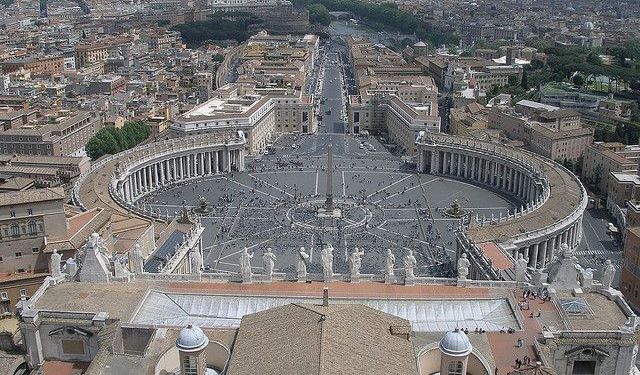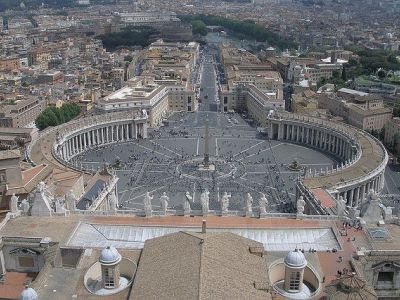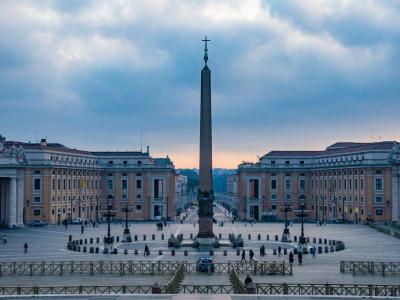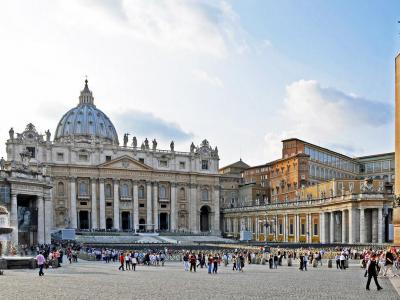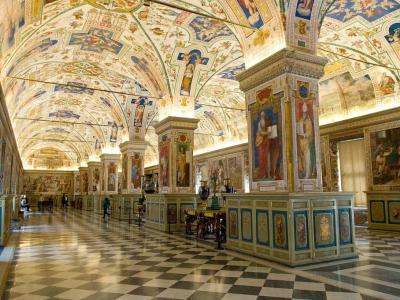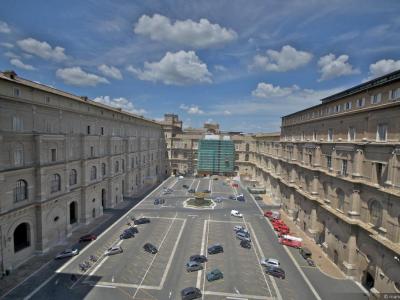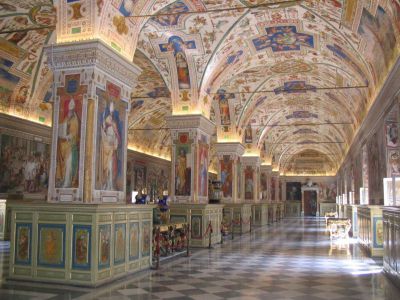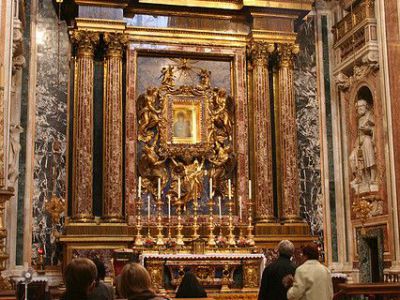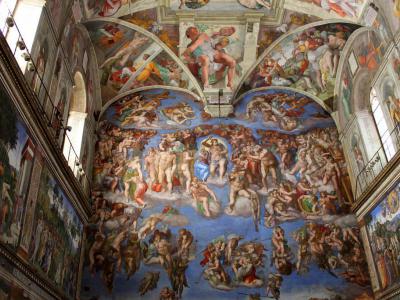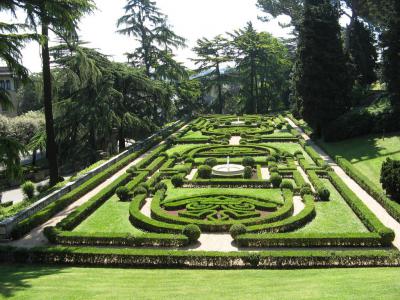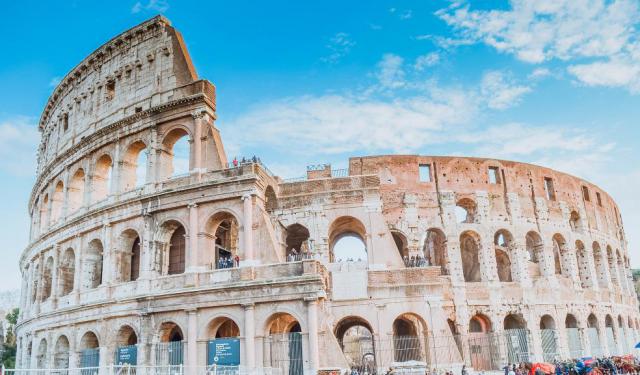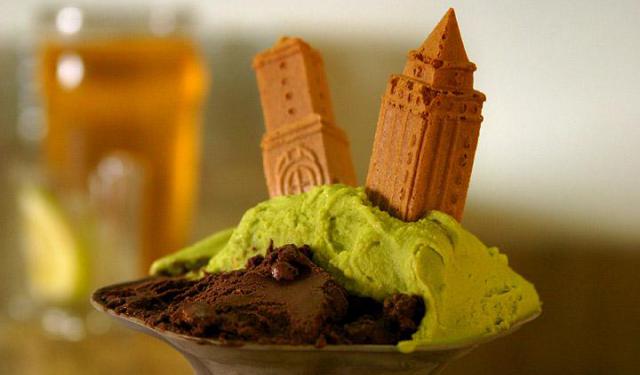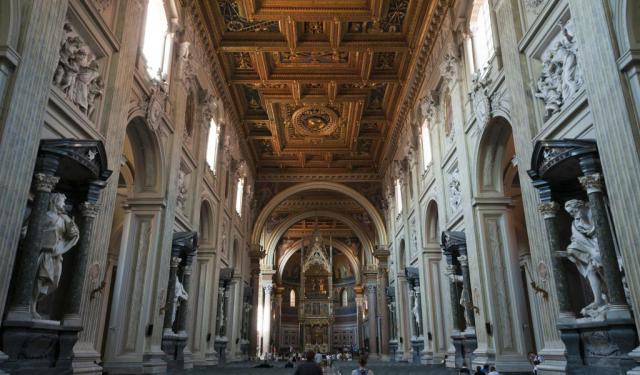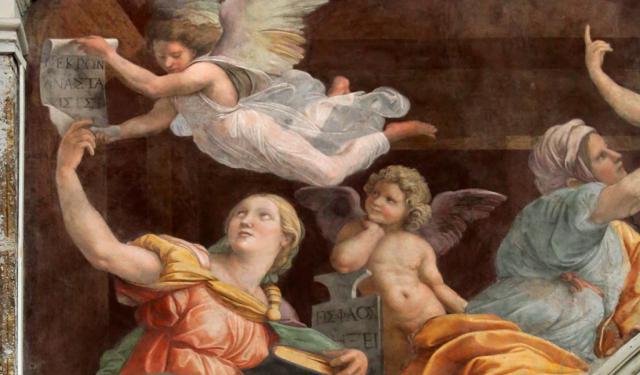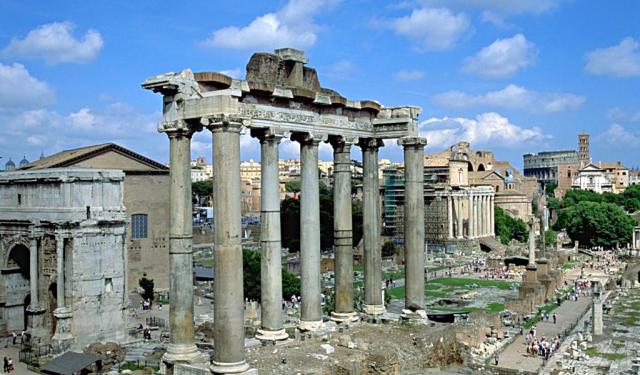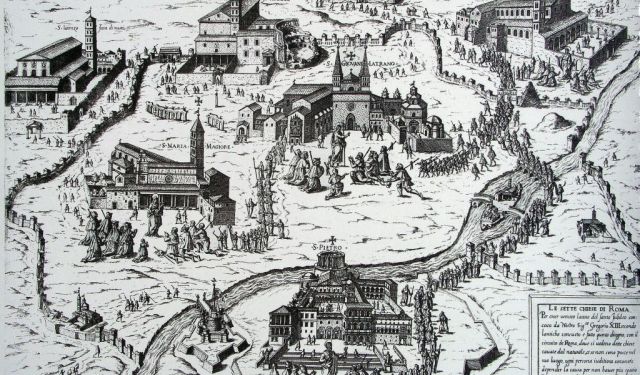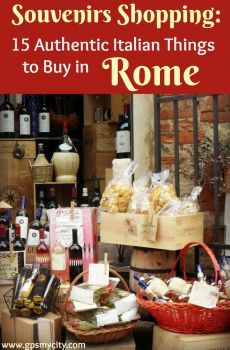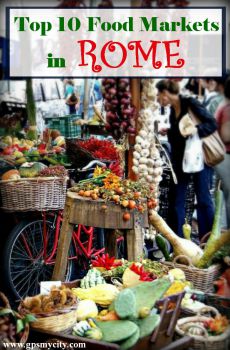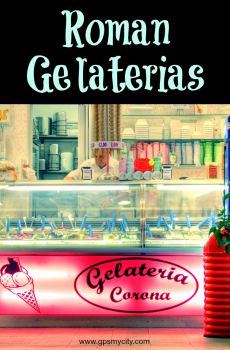Audio Guide: Vatican Walking Tour (Self Guided), Rome
Consisting of a walled enclave within the city of Rome, the Vatican is the world’s smallest sovereign state, as well as a symbol (and headquarters) of the Roman Catholic faith. Although only 44 hectares in surface, one is amazed by the vastness of this place and the sheer size of everything. When gazing around in all directions, you realize how much can be achieved by people working in faith for a common purpose.
Did you know that the obelisk of St. Peter's Square works like a huge solar clock that marks the hours and days? Although the height it has today is half the size of the Egyptian original, moving such a delicate structure to where it stands required the help of 900 men and 150 horses.
The largest Christian church building in the world, Saint Peter's Basilica leaves you speechless with its magnificence. Full of important statues and monuments, among which the stunningly beautiful Pietà by Michelangelo, it also affords nice views over Rome, provided you pay for the lift.
All arts and all periods – from Egyptian to contemporary painting – are covered in the Vatican Museums’ galleries nearby, so make sure you give yourself plenty of time, as there are many hours’ worth of exhibitions.
Other treats, such as the famous Sistine Chapel with its floor-to-ceiling frescoes, or the perfectly manicured Vatican Gardens, await you at the end of the itinerary.
With such a unique collection of artistic and architectural masterpieces lying within the boundaries of this small state, follow our self-guided walking tour to find your way around and make the most of your time.
Getting to Sight #1. The first tour stop (St. Peter's Square) can be reach by Bus: Bus: 23, 31, 49, 490, 40 Express and and 116 electric bus; Train: FL3, Metro: line A.
Did you know that the obelisk of St. Peter's Square works like a huge solar clock that marks the hours and days? Although the height it has today is half the size of the Egyptian original, moving such a delicate structure to where it stands required the help of 900 men and 150 horses.
The largest Christian church building in the world, Saint Peter's Basilica leaves you speechless with its magnificence. Full of important statues and monuments, among which the stunningly beautiful Pietà by Michelangelo, it also affords nice views over Rome, provided you pay for the lift.
All arts and all periods – from Egyptian to contemporary painting – are covered in the Vatican Museums’ galleries nearby, so make sure you give yourself plenty of time, as there are many hours’ worth of exhibitions.
Other treats, such as the famous Sistine Chapel with its floor-to-ceiling frescoes, or the perfectly manicured Vatican Gardens, await you at the end of the itinerary.
With such a unique collection of artistic and architectural masterpieces lying within the boundaries of this small state, follow our self-guided walking tour to find your way around and make the most of your time.
Getting to Sight #1. The first tour stop (St. Peter's Square) can be reach by Bus: Bus: 23, 31, 49, 490, 40 Express and and 116 electric bus; Train: FL3, Metro: line A.
How it works: Download the app "GPSmyCity: Walks in 1K+ Cities" from Apple App Store or Google Play Store to your mobile phone or tablet. The app turns your mobile device into a personal tour guide and its built-in GPS navigation functions guide you from one tour stop to next. The app works offline, so no data plan is needed when traveling abroad.
Vatican Walking Tour Map
Guide Name: Vatican Walking Tour
Guide Location: Italy » Rome (See other walking tours in Rome)
Guide Type: Self-guided Walking Tour (Sightseeing)
# of Attractions: 9
Tour Duration: 2 Hour(s)
Travel Distance: 3.4 Km or 2.1 Miles
Author: DanaOffice
Sight(s) Featured in This Guide:
Guide Location: Italy » Rome (See other walking tours in Rome)
Guide Type: Self-guided Walking Tour (Sightseeing)
# of Attractions: 9
Tour Duration: 2 Hour(s)
Travel Distance: 3.4 Km or 2.1 Miles
Author: DanaOffice
Sight(s) Featured in This Guide:
- Piazza San Pietro (St. Peter's Square)
- Obelisco Vaticano (Obelisk of St Peter's Square)
- Basilica Papale di San Pietro in Vaticano (Saint Peter's Basilica)
- Musei Vaticani (Vatican Museums)
- Cortile del Belvedere (Belvedere Courtyard)
- Biblioteca Apostolica Vaticana (Vatican Apostolic Library)
- Cappella Paolina (Pauline Chapel)
- Cappella Sistina (Sistine Chapel)
- Giardini Vaticani (Gardens of Vatican City)
1) Piazza San Pietro (St. Peter's Square) (must see)
Saint Peter's Square is a grand plaza in front of Saint Peter's Basilica in Vatican City. Both the square and the basilica (the largest Christian temple and spiritual heart of Catholicism), are dedicated to Saint Peter, one of Jesus’s apostles, who is also regarded as the first Pope.
Dominating the square's center is the Vatican obelisk, a red granite structure, rising to approximately 25 meters (or 83 feet). Originally erected in Heliopolis, Egypt, it was moved to Rome by Emperor Caligula in the 1st century AD and was finally relocated to its current position in 1586 by engineer Domenico Fontana under Pope Sixtus V. The obelisk, adorned with bronze lions and a cross-topped Chigi family crest, has remained intact since antiquity. It serves as the plaza's focal point and symbolizes the triumph of Christianity over paganism.
Designed by Gian Lorenzo Bernini between 1656 and 1667 under Pope Alexander VII, the square was intended to maximize visibility for papal blessings. Bernini incorporated colossal Tuscan colonnades, which are four columns deep and comprise 284 columns and 88 pilasters. The colonnades encircle the oval-shaped plaza, symbolizing the "maternal arms of Mother Church." The trapezoidal approach enhances the visual impact, a hallmark of Baroque design.
The square also features two matching fountains, flanking the obelisk, created by Carlo Maderno and Bernini (in 1613 and 1675 respectively), balancing the architectural harmony. The fountains represent the life-giving waters of the Christian faith.
The paving of the square includes travertine lines that radiate outward, breaking up the vast stone surface. In 1817, circular stones were added to transform the obelisk into a giant sundial, marking the sun’s position as it enters each zodiac sign.
Saint Peter's Square is accessible via Conciliation Street, an avenue created between 1937 and 1950 following the demolition of the medieval “spina” area. Its removal, under Mussolini's directive, made the basilica visible from Saint Angel's Castle.
Apart from being an architectural marvel, today the square serves as a gathering space for momentous events and ceremonies within the Catholic Church. These attract annually millions of visitors and pilgrims from across the globe seeking to attend papal audiences and receive blessings from the Pope. During significant occasions like Easter Sunday and Christmas, the square transforms into a splendid backdrop for grand celebrations and religious rituals, much as for capturing memorable photos.
Dominating the square's center is the Vatican obelisk, a red granite structure, rising to approximately 25 meters (or 83 feet). Originally erected in Heliopolis, Egypt, it was moved to Rome by Emperor Caligula in the 1st century AD and was finally relocated to its current position in 1586 by engineer Domenico Fontana under Pope Sixtus V. The obelisk, adorned with bronze lions and a cross-topped Chigi family crest, has remained intact since antiquity. It serves as the plaza's focal point and symbolizes the triumph of Christianity over paganism.
Designed by Gian Lorenzo Bernini between 1656 and 1667 under Pope Alexander VII, the square was intended to maximize visibility for papal blessings. Bernini incorporated colossal Tuscan colonnades, which are four columns deep and comprise 284 columns and 88 pilasters. The colonnades encircle the oval-shaped plaza, symbolizing the "maternal arms of Mother Church." The trapezoidal approach enhances the visual impact, a hallmark of Baroque design.
The square also features two matching fountains, flanking the obelisk, created by Carlo Maderno and Bernini (in 1613 and 1675 respectively), balancing the architectural harmony. The fountains represent the life-giving waters of the Christian faith.
The paving of the square includes travertine lines that radiate outward, breaking up the vast stone surface. In 1817, circular stones were added to transform the obelisk into a giant sundial, marking the sun’s position as it enters each zodiac sign.
Saint Peter's Square is accessible via Conciliation Street, an avenue created between 1937 and 1950 following the demolition of the medieval “spina” area. Its removal, under Mussolini's directive, made the basilica visible from Saint Angel's Castle.
Apart from being an architectural marvel, today the square serves as a gathering space for momentous events and ceremonies within the Catholic Church. These attract annually millions of visitors and pilgrims from across the globe seeking to attend papal audiences and receive blessings from the Pope. During significant occasions like Easter Sunday and Christmas, the square transforms into a splendid backdrop for grand celebrations and religious rituals, much as for capturing memorable photos.
2) Obelisco Vaticano (Obelisk of St Peter's Square)
Rome hosts the largest collection of obelisks in the world, including eight Egyptian and five Roman ones. While Egyptian obelisks were typically erected as single blocks in front of temples or pyramids honoring the sun god Ra, Roman obelisks often served as dedications to the ruling emperor of the time. Unlike their Egyptian counterparts adorned with hieroglyphics, Roman obelisks were simpler in design.
The obelisk in Saint Peter's Square has a fascinating history. Now known as the Vatican Obelisk, it was brought from Heliopolis, Egypt, by Emperor Caligula in 40 AD. Transporting obelisks was a complex and challenging task, requiring the construction of special boats, known as "obelisk boats", designed specifically for the purpose. The Caligula obelisk was originally installed at the center of his circus, later known as the Circus of Nero. This site is now largely encompassed by Vatican City.
Saint Peter was martyred in Rome in 64 AD under Emperor Nero. According to legend, he was crucified upside down, at his own request, deeming himself unworthy to die like Jesus. His crucifixion occurred in the Circus of Nero near the obelisk, which is now revered as a memorial “witness” to Peter’s death.
In 1586, Pope Sixtus V ordered relocating the obelisk to its current position next to Saint Peter’s Basilica, as a symbolic gesture representing the triumph of Christianity over paganism. This monumental task, directed by architect Domenico Fontana, took over 13 months of preparation and the use of 800 men, 160 horses, and 45 winches. On the day of the move, a sailor named Benedetto Bresca famously shouted, “Water on the ropes!” to prevent the ropes from snapping under the obelisk's weight.
A medieval legend held that the bronze globe atop the obelisk once contained the ashes of Julius Caesar or Trajan. During the obelisk relocation, the globe was removed and eventually placed in the Conservators' Palace in 1848. Sixtus V granted indulgences to those venerating the cross atop the obelisk which was believed to have included a relic of the True Cross within it. However, no relic was discovered during later restorations. In 1740, a reliquary from Saint Peter’s Basilica was placed inside the cross.
The red granite monument reaches a height of over 25 meters (or nearly 40 meters together with its cross and bronze-lion base) and is the only ancient obelisk in Rome that has never fallen.
The obelisk’s inscriptions reflect its historical journey. Two ancient inscriptions commemorate its dedication to the emperors Augustus and Tiberius, while four inscriptions added during its re-dedication in 1586 highlight its Christian significance. These include declarations of Christ’s victory and the acknowledgment of Domenico Fontana’s pivotal role in moving and erecting the obelisk.
The obelisk in Saint Peter's Square has a fascinating history. Now known as the Vatican Obelisk, it was brought from Heliopolis, Egypt, by Emperor Caligula in 40 AD. Transporting obelisks was a complex and challenging task, requiring the construction of special boats, known as "obelisk boats", designed specifically for the purpose. The Caligula obelisk was originally installed at the center of his circus, later known as the Circus of Nero. This site is now largely encompassed by Vatican City.
Saint Peter was martyred in Rome in 64 AD under Emperor Nero. According to legend, he was crucified upside down, at his own request, deeming himself unworthy to die like Jesus. His crucifixion occurred in the Circus of Nero near the obelisk, which is now revered as a memorial “witness” to Peter’s death.
In 1586, Pope Sixtus V ordered relocating the obelisk to its current position next to Saint Peter’s Basilica, as a symbolic gesture representing the triumph of Christianity over paganism. This monumental task, directed by architect Domenico Fontana, took over 13 months of preparation and the use of 800 men, 160 horses, and 45 winches. On the day of the move, a sailor named Benedetto Bresca famously shouted, “Water on the ropes!” to prevent the ropes from snapping under the obelisk's weight.
A medieval legend held that the bronze globe atop the obelisk once contained the ashes of Julius Caesar or Trajan. During the obelisk relocation, the globe was removed and eventually placed in the Conservators' Palace in 1848. Sixtus V granted indulgences to those venerating the cross atop the obelisk which was believed to have included a relic of the True Cross within it. However, no relic was discovered during later restorations. In 1740, a reliquary from Saint Peter’s Basilica was placed inside the cross.
The red granite monument reaches a height of over 25 meters (or nearly 40 meters together with its cross and bronze-lion base) and is the only ancient obelisk in Rome that has never fallen.
The obelisk’s inscriptions reflect its historical journey. Two ancient inscriptions commemorate its dedication to the emperors Augustus and Tiberius, while four inscriptions added during its re-dedication in 1586 highlight its Christian significance. These include declarations of Christ’s victory and the acknowledgment of Domenico Fontana’s pivotal role in moving and erecting the obelisk.
3) Basilica Papale di San Pietro in Vaticano (Saint Peter's Basilica) (must see)
Despite not being the mother church of Catholicism or Rome's cathedral, Saint Peter's Basilica in the Vatican is one of Christianity's holiest sites. Tradition holds that Saint Peter, the first Bishop of Rome, is buried inside, beneath the high altar, known as the Altar of the Confession.
Built to replace the aging original basilica, the new construction began in 1506, under Pope Julius II, and was completed in 1626. Designed by Renaissance masters such as Donato Bramante, Michelangelo, and Carlo Maderno, the structure embodies the grandeur of Italian High Renaissance architecture. Its vast interior makes it the largest church in the world by space.
The Latin cross layout features a vast dome, spanning 42 meters in diameter and towering 120 meters high. Meanwhile, the imposing façade adorned with statues of Saints Peter and Paul is complemented by a narthex housing the Holy Door. The latter, walled up with bricks, is opened only during jubilee years. Inside, the immense nave, wide aisles, and chapels are decorated with elaborate sculptures and artwork. Among these are Michelangelo’s Pietà and Bernini’s Baldachin, a monumental canopy over the Papal Altar. Other notable artworks include Giotto’s Navicella mosaic and equestrian statues of Constantine and Charlemagne.
Michelangelo played a crucial role in shaping the place, refining its design into a more unified and monumental form. His dome, completed in 1590, has profoundly influenced Western church architecture. Slightly more pointed than Michelangelo's original plan, the dome's design blends Renaissance ideals with Baroque dynamism. Encircling the interior is an inscription that reads: "You are Peter, and on this rock I will build my church... and I will give you the keys of the kingdom of heaven."
The basilica also has six bells. The largest of them, "Campanone," weighs 9 tons and is used for ringing for papal blessings. Up on the roof are the sculptures of Christ the Redeemer, Saint John the Baptist, and 11 Apostles. Meanwhile, inside, there are over 100 tombs. Among those laid to rest are many popes, including Pope Jean Paul II, royals, and other historical figures, such as Holy Roman Emperor Otto II and Italian composer Giovanni Pierluigi da Palestrina.
Tips:
Arrive early in the morning to avoid long queues. Admission is free (until 5 PM when the gates close), but expect to undergo a security check before entering. Remember to dress modestly, with knees and shoulders covered (affordable scarves for ladies are available from nearby vendors). If you're feeling adventurous, ascend to the top of the dome. An elevator ride can save you from climbing more than 300 stairs.
Built to replace the aging original basilica, the new construction began in 1506, under Pope Julius II, and was completed in 1626. Designed by Renaissance masters such as Donato Bramante, Michelangelo, and Carlo Maderno, the structure embodies the grandeur of Italian High Renaissance architecture. Its vast interior makes it the largest church in the world by space.
The Latin cross layout features a vast dome, spanning 42 meters in diameter and towering 120 meters high. Meanwhile, the imposing façade adorned with statues of Saints Peter and Paul is complemented by a narthex housing the Holy Door. The latter, walled up with bricks, is opened only during jubilee years. Inside, the immense nave, wide aisles, and chapels are decorated with elaborate sculptures and artwork. Among these are Michelangelo’s Pietà and Bernini’s Baldachin, a monumental canopy over the Papal Altar. Other notable artworks include Giotto’s Navicella mosaic and equestrian statues of Constantine and Charlemagne.
Michelangelo played a crucial role in shaping the place, refining its design into a more unified and monumental form. His dome, completed in 1590, has profoundly influenced Western church architecture. Slightly more pointed than Michelangelo's original plan, the dome's design blends Renaissance ideals with Baroque dynamism. Encircling the interior is an inscription that reads: "You are Peter, and on this rock I will build my church... and I will give you the keys of the kingdom of heaven."
The basilica also has six bells. The largest of them, "Campanone," weighs 9 tons and is used for ringing for papal blessings. Up on the roof are the sculptures of Christ the Redeemer, Saint John the Baptist, and 11 Apostles. Meanwhile, inside, there are over 100 tombs. Among those laid to rest are many popes, including Pope Jean Paul II, royals, and other historical figures, such as Holy Roman Emperor Otto II and Italian composer Giovanni Pierluigi da Palestrina.
Tips:
Arrive early in the morning to avoid long queues. Admission is free (until 5 PM when the gates close), but expect to undergo a security check before entering. Remember to dress modestly, with knees and shoulders covered (affordable scarves for ladies are available from nearby vendors). If you're feeling adventurous, ascend to the top of the dome. An elevator ride can save you from climbing more than 300 stairs.
4) Musei Vaticani (Vatican Museums) (must see)
The Vatican Museums house an extensive collection of art and historical artifacts amassed by the Catholic Church over centuries. With approximately 70,000 works, of which 20,000 are on display, they rank among the most significant museums in the world and are the second most-visited art museum after the Louvre.
The museums trace their origins to Pope Julius II in the early 16th century. Their foundation is closely linked to the discovery of the famous Roman sculpture "Laocoon and His Sons" in 1506. Following expert advice from Michelangelo and Giuliano da Sangallo, who was an Italian sculptor, architect, and military engineer, the Pope acquired the piece and put it on display. Over time, the collection expanded, with Pope Pius IX establishing the Museum Christianum and Lateran Museum in 1854. In 2006, the museums celebrated their 500th anniversary by opening the Vatican Hill necropolis to the public.
The museums include 24 galleries, culminating in the Sistine Chapel, famous for Michelangelo’s frescoed ceiling and The Last Judgment. Other highlights include the Raphael Rooms, featuring masterpieces like The School of Athens, and the Vatican Art Gallery, showcasing works by Giotto, Leonardo da Vinci, Raphael, Titian, Caravaggio, and Veronese.
Several museums surrounding the Belvedere Courtyard specialize in sculpture. The Pio-Clementino Museum is the most prominent, housing Greek and Roman sculptures, such as Apollo Belvedere and Laocoön and His Sons. The Chiaramonti Museum displays statues, friezes, and sarcophagi, while the Gregoriano Etrusco and Gregoriano Egiziano museums feature Etruscan and Egyptian antiquities, respectively.
The Vatican Historical Museum (established in 1973) displays papal artifacts, including a red marble papal throne. The Gallery of Maps, commissioned by Pope Gregory XIII, remains the largest geographical pictorial study ever created. The Borgia Apartment, once home to Pope Alexander VI, contains Renaissance frescoes. Another highlight is the Bramante Staircase, a stunning double-helix design from 1932.
Tip:
Before embarking on a visit, ensure you have a satisfying breakfast and wear comfortable walking shoes. It can be helpful to prioritize a few key pieces of art that you don't want to miss and focus on experiencing those. Alternatively, if you wish to explore the entire collection, plan for multiple visits.
It is highly recommended to book tickets in advance online, particularly for an afternoon visit during the middle of the week. Saturdays and Mondays tend to be the busiest days, so opting for other times can enhance your experience.
The museums trace their origins to Pope Julius II in the early 16th century. Their foundation is closely linked to the discovery of the famous Roman sculpture "Laocoon and His Sons" in 1506. Following expert advice from Michelangelo and Giuliano da Sangallo, who was an Italian sculptor, architect, and military engineer, the Pope acquired the piece and put it on display. Over time, the collection expanded, with Pope Pius IX establishing the Museum Christianum and Lateran Museum in 1854. In 2006, the museums celebrated their 500th anniversary by opening the Vatican Hill necropolis to the public.
The museums include 24 galleries, culminating in the Sistine Chapel, famous for Michelangelo’s frescoed ceiling and The Last Judgment. Other highlights include the Raphael Rooms, featuring masterpieces like The School of Athens, and the Vatican Art Gallery, showcasing works by Giotto, Leonardo da Vinci, Raphael, Titian, Caravaggio, and Veronese.
Several museums surrounding the Belvedere Courtyard specialize in sculpture. The Pio-Clementino Museum is the most prominent, housing Greek and Roman sculptures, such as Apollo Belvedere and Laocoön and His Sons. The Chiaramonti Museum displays statues, friezes, and sarcophagi, while the Gregoriano Etrusco and Gregoriano Egiziano museums feature Etruscan and Egyptian antiquities, respectively.
The Vatican Historical Museum (established in 1973) displays papal artifacts, including a red marble papal throne. The Gallery of Maps, commissioned by Pope Gregory XIII, remains the largest geographical pictorial study ever created. The Borgia Apartment, once home to Pope Alexander VI, contains Renaissance frescoes. Another highlight is the Bramante Staircase, a stunning double-helix design from 1932.
Tip:
Before embarking on a visit, ensure you have a satisfying breakfast and wear comfortable walking shoes. It can be helpful to prioritize a few key pieces of art that you don't want to miss and focus on experiencing those. Alternatively, if you wish to explore the entire collection, plan for multiple visits.
It is highly recommended to book tickets in advance online, particularly for an afternoon visit during the middle of the week. Saturdays and Mondays tend to be the busiest days, so opting for other times can enhance your experience.
5) Cortile del Belvedere (Belvedere Courtyard)
The Belvedere Courtyard was a significant architectural achievement of the High Renaissance period. It was designed by Donato Bramante in 1505 to connect the Vatican Palace with the Villa Belvedere. The courtyard’s design had a lasting influence on European architecture, inspiring courtyards, formal squares, and garden layouts. Originally conceived as a unified space with terraces linked by stairways, its integrity was later compromised when a new structure divided it into two separate courtyards in the late 16th century.
The Villa Belvedere, built in 1484 by Pope Innocent VIII, was positioned on higher ground to provide a summer retreat with cooling breezes and panoramic views. As such, it was the first purpose-built Roman pleasure villa since antiquity. Pope Julius II, upon ascending the papal throne in 1503, transformed the villa into a repository for ancient Roman sculptures, including the famed “Laocoön and His Sons” and “Apollo Belvedere.”
Julius II commissioned Bramante to integrate the villa with the Vatican Palace, using a series of terraces and symmetrical staircases to create an elegant, structured sequence of spaces. This architectural unity was unprecedented in scale and impact. A grand staircase led through six terraces, culminating at the uppermost exedra, a semicircular feature that masked the villa’s misalignment with the Vatican facade. The design was intended to be viewed from Raphael’s Rooms in the papal apartments.
Over time, the courtyard served multiple functions. Pope Leo X used the lower terrace for his menagerie, even parading his beloved elephant Hanno here before its burial on-site. The open space hosted festivals, pageants, and jousts, with bleachers installed for spectators. The upper terraces featured patterned gardens, as depicted in 16th-century engravings.
However, in 1585–1590, Pope Sixtus V disrupted the original design by constructing a Vatican Library wing, splitting the courtyard. Some believe this change was intentional, aimed to obscure the classical sculptures that Pope Adrian VI had condemned as "pagan idols." Today, the lower terrace retains the name the Belvedere Courtyard, while the upper part is called the Pine Cone Courtyard, named after the massive bronze pinecone displayed there.
In 1990, the space gained a modern touch with Arnaldo Pomodoro’s sculpture, Sphere Within Sphere, adding a contemporary contrast to this historically rich site.
The Villa Belvedere, built in 1484 by Pope Innocent VIII, was positioned on higher ground to provide a summer retreat with cooling breezes and panoramic views. As such, it was the first purpose-built Roman pleasure villa since antiquity. Pope Julius II, upon ascending the papal throne in 1503, transformed the villa into a repository for ancient Roman sculptures, including the famed “Laocoön and His Sons” and “Apollo Belvedere.”
Julius II commissioned Bramante to integrate the villa with the Vatican Palace, using a series of terraces and symmetrical staircases to create an elegant, structured sequence of spaces. This architectural unity was unprecedented in scale and impact. A grand staircase led through six terraces, culminating at the uppermost exedra, a semicircular feature that masked the villa’s misalignment with the Vatican facade. The design was intended to be viewed from Raphael’s Rooms in the papal apartments.
Over time, the courtyard served multiple functions. Pope Leo X used the lower terrace for his menagerie, even parading his beloved elephant Hanno here before its burial on-site. The open space hosted festivals, pageants, and jousts, with bleachers installed for spectators. The upper terraces featured patterned gardens, as depicted in 16th-century engravings.
However, in 1585–1590, Pope Sixtus V disrupted the original design by constructing a Vatican Library wing, splitting the courtyard. Some believe this change was intentional, aimed to obscure the classical sculptures that Pope Adrian VI had condemned as "pagan idols." Today, the lower terrace retains the name the Belvedere Courtyard, while the upper part is called the Pine Cone Courtyard, named after the massive bronze pinecone displayed there.
In 1990, the space gained a modern touch with Arnaldo Pomodoro’s sculpture, Sphere Within Sphere, adding a contemporary contrast to this historically rich site.
6) Biblioteca Apostolica Vaticana (Vatican Apostolic Library)
The Vatican Apostolic Library, one of the world’s oldest and most prestigious libraries, holds an extensive collection of historical texts and manuscripts. It is located within the Vatican Palace and can be accessed through the Belvedere Courtyard. While officially established in 1475, its origins trace back much earlier, making it a vital repository of historical and cultural heritage.
The library’s foundation began in 1448 when Pope Nicholas V consolidated approximately 350 Greek, Latin, and Hebrew manuscripts from his predecessors with his own private collection and new acquisitions. These included texts from the Library of Constantinople. By 1455, Nicholas V had expanded the library to 1,200 books, solidifying its role as a major intellectual center. Under Pope Sixtus IV, it grew into the Palatine Library, the largest in Western Europe at the time. Later, Pope Sixtus V (who held office from 1585 to 1590) commissioned Domenico Fontana to construct a new building, which remains in use today. In its early years, books were displayed on benches and chained to prevent theft.
The library’s collection continued to grow through various acquisitions and gifts. In 1623, the Palatine Library of Heidelberg was transferred here. The Dukes of Urbino’s manuscripts were added in 1657, followed by Queen Christina of Sweden’s collection in 1689. Under Pope Clement XI, an Oriental section was established. The Vatican Film Library, created in 1959, further expanded its holdings.
Today, the Vatican Library houses 75,000 ancient manuscripts, 1.1 million printed books, and 8,500 so-called “incunabula” – the books printed before the invention of the printing press. Notable treasures include one of the oldest nearly complete Bibles – in Greek (dated the 4th century); the Codex Borgia, an important Mesoamerican manuscript; and a tiny 45mm Quran.
The vast facility includes 42 km (or 26 miles) of shelving, along with specialized areas for manuscript storage, restoration, and photographic archiving. The Vatican Secret Archives, now called the Vatican Apostolic Archive, was separated from the library in the 17th century and holds 150,000 additional documents of historical importance.
Although primarily known for its theological texts, the library also preserves significant secular works, particularly Greek and Latin classics that were essential to the Renaissance. Some 6,000 new books are acquired annually. Additionally, the collection comprises 330,000 coins and medals.
As a research library for scholars in history, law, philosophy, science, and theology, the Vatican Apostolic Library remains an essential institution for global intellectual and cultural heritage. Access is restricted to qualified researchers, ensuring that its invaluable resources continue to be studied and preserved.
The library’s foundation began in 1448 when Pope Nicholas V consolidated approximately 350 Greek, Latin, and Hebrew manuscripts from his predecessors with his own private collection and new acquisitions. These included texts from the Library of Constantinople. By 1455, Nicholas V had expanded the library to 1,200 books, solidifying its role as a major intellectual center. Under Pope Sixtus IV, it grew into the Palatine Library, the largest in Western Europe at the time. Later, Pope Sixtus V (who held office from 1585 to 1590) commissioned Domenico Fontana to construct a new building, which remains in use today. In its early years, books were displayed on benches and chained to prevent theft.
The library’s collection continued to grow through various acquisitions and gifts. In 1623, the Palatine Library of Heidelberg was transferred here. The Dukes of Urbino’s manuscripts were added in 1657, followed by Queen Christina of Sweden’s collection in 1689. Under Pope Clement XI, an Oriental section was established. The Vatican Film Library, created in 1959, further expanded its holdings.
Today, the Vatican Library houses 75,000 ancient manuscripts, 1.1 million printed books, and 8,500 so-called “incunabula” – the books printed before the invention of the printing press. Notable treasures include one of the oldest nearly complete Bibles – in Greek (dated the 4th century); the Codex Borgia, an important Mesoamerican manuscript; and a tiny 45mm Quran.
The vast facility includes 42 km (or 26 miles) of shelving, along with specialized areas for manuscript storage, restoration, and photographic archiving. The Vatican Secret Archives, now called the Vatican Apostolic Archive, was separated from the library in the 17th century and holds 150,000 additional documents of historical importance.
Although primarily known for its theological texts, the library also preserves significant secular works, particularly Greek and Latin classics that were essential to the Renaissance. Some 6,000 new books are acquired annually. Additionally, the collection comprises 330,000 coins and medals.
As a research library for scholars in history, law, philosophy, science, and theology, the Vatican Apostolic Library remains an essential institution for global intellectual and cultural heritage. Access is restricted to qualified researchers, ensuring that its invaluable resources continue to be studied and preserved.
7) Cappella Paolina (Pauline Chapel)
The Pauline Chapel of the Vatican Apostolic Palace is a historically significant yet often overlooked site. Unlike the nearby Sistine Chapel, from which it is separated by the Royal Hall, it is not included in standard tourist routes.
Commissioned by Pope Paul III in 1538, the chapel was completed in 1540. It was dedicated to the Feast of the Conversion of Saint Paul, a significant occasion for the Pope. Originally, it served as the Chapel of the Concave and the Chapel of the Sacrament.
The chapel’s artistic significance lies in its two Michelangelo frescoes, The Conversion of Saul and The Crucifixion of Saint Peter, painted between 1542 and 1549. Though created at the height of Michelangelo’s fame, these frescoes were initially met with disappointment. Their unconventional composition and narrative approach diverged from contemporary artistic expectations, causing them to be overshadowed by Michelangelo’s more famous works, such as the Sistine Chapel frescoes. Modern analysis has identified Michelangelo’s self-portrait within these paintings, revealed through facial superimposition.
Despite being in his 60s, exhausted, and still occupied with Pope Julius II’s tomb, Michelangelo was personally chosen by Pope Paul III to execute the frescoes. Even before completing The Last Judgment, the Pope insisted that Michelangelo take on the project. The frescoes reflect a stylistic departure from grace and idealized beauty, leaning toward a more narrative-driven approach. This shift is particularly evident in The Conversion of Saul, where Saul is depicted as an elderly man, possibly mirroring Michelangelo’s own weariness.
Beyond its artistic significance, the Pauline Chapel played an essential role in papal conclaves. In 1549-1550, the chapel hosted the conclave that elected Pope Julius III, as the Sistine Chapel was used for infirm cardinals. According to the 1996 document Whole Flock of the Lord, the Pauline Chapel serves as the gathering place for cardinal-electors before entering the Sistine Chapel for a conclave.
The chapel underwent a major restoration from 2004 to 2009, during which layers of accumulated dirt were removed, revealing the frescoes’ original vibrancy. While unavailable for the 2005 conclave, it was reinstated for the 2013 conclave, where cardinals gathered to take the oath of secrecy. In 2010, the Vatican introduced a virtual reality rendering of the chapel, offering a detailed digital tour of its restored brilliance.
Commissioned by Pope Paul III in 1538, the chapel was completed in 1540. It was dedicated to the Feast of the Conversion of Saint Paul, a significant occasion for the Pope. Originally, it served as the Chapel of the Concave and the Chapel of the Sacrament.
The chapel’s artistic significance lies in its two Michelangelo frescoes, The Conversion of Saul and The Crucifixion of Saint Peter, painted between 1542 and 1549. Though created at the height of Michelangelo’s fame, these frescoes were initially met with disappointment. Their unconventional composition and narrative approach diverged from contemporary artistic expectations, causing them to be overshadowed by Michelangelo’s more famous works, such as the Sistine Chapel frescoes. Modern analysis has identified Michelangelo’s self-portrait within these paintings, revealed through facial superimposition.
Despite being in his 60s, exhausted, and still occupied with Pope Julius II’s tomb, Michelangelo was personally chosen by Pope Paul III to execute the frescoes. Even before completing The Last Judgment, the Pope insisted that Michelangelo take on the project. The frescoes reflect a stylistic departure from grace and idealized beauty, leaning toward a more narrative-driven approach. This shift is particularly evident in The Conversion of Saul, where Saul is depicted as an elderly man, possibly mirroring Michelangelo’s own weariness.
Beyond its artistic significance, the Pauline Chapel played an essential role in papal conclaves. In 1549-1550, the chapel hosted the conclave that elected Pope Julius III, as the Sistine Chapel was used for infirm cardinals. According to the 1996 document Whole Flock of the Lord, the Pauline Chapel serves as the gathering place for cardinal-electors before entering the Sistine Chapel for a conclave.
The chapel underwent a major restoration from 2004 to 2009, during which layers of accumulated dirt were removed, revealing the frescoes’ original vibrancy. While unavailable for the 2005 conclave, it was reinstated for the 2013 conclave, where cardinals gathered to take the oath of secrecy. In 2010, the Vatican introduced a virtual reality rendering of the chapel, offering a detailed digital tour of its restored brilliance.
8) Cappella Sistina (Sistine Chapel) (must see)
The Sistine Chapel is one of the most significant artistic and religious landmarks in the world. Originally known as the "Great Chapel," it was reconstructed and consecrated between 1473 and 1483, under Pope Sixtus IV; hence its name.
The chapel’s fame largely stems from its breathtaking frescoes, particularly Michelangelo’s ceiling and The Last Judgment on the altar wall. Before that, Renaissance painters such as Botticelli, Perugino, and several others had already adorned the side walls with depictions of The Life of Moses and The Life of Christ. Above these biblical scenes, portraits of popes and “deceive the eye” drapery added to the visual splendor. Raphael later designed tapestries for the lower walls in 1515, though many were looted and only partially restored in the 20th century.
Under the patronage of Pope Julius II, in 1508, Michelangelo repainted the chapel's ceiling, originally decorated with a blue background and golden stars. Despite considering himself more of a sculptor than a painter, he undertook the monumental task, conditioned he was given full artistic control. Michelangelo's work, completed in 1512, transformed Western art with vivid colors and a masterful composition that depicted The Creation of the World, The Fall of Man, and The Redemption of Humanity. More than 300 figures, arranged in three layers, included prophets, ancestors of Christ, and nine dramatic scenes from Genesis, covering over 5,000 square feet.
These frescoes are accompanied by the presence of male nudes. Additionally, the spandrels surrounding the vault feature sibyls, prophetesses from pagan mythology, who were embraced by Christian artists during the Renaissance as capable of foreseeing the arrival of Christ. One of the most iconic paintings within the chapel is The Creation of Adam, portraying God reaching out to create Adam against a backdrop of cloudy heavens. This renowned artwork is among the most reproduced religious paintings in history.
In 1535, under Pope Paul III, Michelangelo returned to paint "The Last Judgment" and completed it in 1541. This monumental fresco, portraying Christ’s Second Coming, stirred controversy due to its nude figures, leading to a censorship campaign. The artist mocked critics by incorporating their likenesses into the painting, while later interventions saw parts of the nudity covered.
The chapel’s structure, measuring 35 meters long, 14 meters wide, and 20 meters high, follows precise Renaissance proportions. Though plain on the outside, its interior is a masterpiece of composition and storytelling.
The chapel’s fame largely stems from its breathtaking frescoes, particularly Michelangelo’s ceiling and The Last Judgment on the altar wall. Before that, Renaissance painters such as Botticelli, Perugino, and several others had already adorned the side walls with depictions of The Life of Moses and The Life of Christ. Above these biblical scenes, portraits of popes and “deceive the eye” drapery added to the visual splendor. Raphael later designed tapestries for the lower walls in 1515, though many were looted and only partially restored in the 20th century.
Under the patronage of Pope Julius II, in 1508, Michelangelo repainted the chapel's ceiling, originally decorated with a blue background and golden stars. Despite considering himself more of a sculptor than a painter, he undertook the monumental task, conditioned he was given full artistic control. Michelangelo's work, completed in 1512, transformed Western art with vivid colors and a masterful composition that depicted The Creation of the World, The Fall of Man, and The Redemption of Humanity. More than 300 figures, arranged in three layers, included prophets, ancestors of Christ, and nine dramatic scenes from Genesis, covering over 5,000 square feet.
These frescoes are accompanied by the presence of male nudes. Additionally, the spandrels surrounding the vault feature sibyls, prophetesses from pagan mythology, who were embraced by Christian artists during the Renaissance as capable of foreseeing the arrival of Christ. One of the most iconic paintings within the chapel is The Creation of Adam, portraying God reaching out to create Adam against a backdrop of cloudy heavens. This renowned artwork is among the most reproduced religious paintings in history.
In 1535, under Pope Paul III, Michelangelo returned to paint "The Last Judgment" and completed it in 1541. This monumental fresco, portraying Christ’s Second Coming, stirred controversy due to its nude figures, leading to a censorship campaign. The artist mocked critics by incorporating their likenesses into the painting, while later interventions saw parts of the nudity covered.
The chapel’s structure, measuring 35 meters long, 14 meters wide, and 20 meters high, follows precise Renaissance proportions. Though plain on the outside, its interior is a masterpiece of composition and storytelling.
9) Giardini Vaticani (Gardens of Vatican City)
The Gardens of Vatican City, also known as the Vatican Gardens, cover over half of the territory of the world’s smallest country. Located in the west of Vatican City, these private gardens are owned by the Pope and contain several important buildings, including Vatican Radio and the Governor’s Palace. The gardens, which span 23 hectares (or 57 acres), feature Renaissance and Baroque designs with fountains, sculptures, and sacred sites. They are enclosed by stone walls on three sides, with the highest point reaching 60 meters (or 197 feet) above sea level.
Though historically private, Pope Francis opened the gardens to the public in 2014, allowing visits with a guided tour. The gardens also house eighteen Marian images venerated worldwide at the Pope’s designation.
A pious tradition states that the gardens' foundation site was spread with sacred soil brought from Mount Calvary in Jerusalem by Empress Saint Helena, symbolically uniting the blood of Christ with that of early Christian martyrs persecuted by Emperor Nero.
Dating back to medieval times, the gardens originally consisted of orchards and vineyards north of the Papal Apostolic Palace. In 1279, Pope Nicholas III enclosed the area with walls and planted an orchard, a lawn, and a garden. Major renovations occurred in the early 16th century under Pope Julius II, when Donato Bramante redesigned the space into three Renaissance-style courtyards: the Belvedere, the Librarian, and the Pine Cone. He also added a boxwood labyrinth framed by Italian stone pines and cedars of Lebanon.
Additionally, the gardens house medieval fortifications, monuments from the 9th century, an artificial Our Lady of Lourdes grotto, and an olive tree donated by Israel. As you explore, you may come across the Vatican's little-known railway station, which has been transformed into a captivating museum showcasing coins and stamps produced within the Vatican. Another notable sight is the Tower of Saint John. Originally restored by Pope John XXIII as a retreat for work, it now serves as a distinguished residence for special guests.
A significant event occurred in 1921 when a fire destroyed the Our Lady of Loreto statue in the Basilica of Loreto. Pope Pius XI commissioned a replacement carved from Vatican Gardens' cedars. The Pope designated Saint Therese of Lisieux as the gardens’ Patroness in 1927, granting her the title of "Sacred Keeper of the Gardens" and constructing a small chapel in her honor near the Leonine Walls.
Tip:
To visit the gardens, you have the option of joining a two-hour guided tour or embarking on a 45-minute open-bus tour without any stops. It's important to note that visits must be booked in advance online, ensuring a seamless and enjoyable experience.
Though historically private, Pope Francis opened the gardens to the public in 2014, allowing visits with a guided tour. The gardens also house eighteen Marian images venerated worldwide at the Pope’s designation.
A pious tradition states that the gardens' foundation site was spread with sacred soil brought from Mount Calvary in Jerusalem by Empress Saint Helena, symbolically uniting the blood of Christ with that of early Christian martyrs persecuted by Emperor Nero.
Dating back to medieval times, the gardens originally consisted of orchards and vineyards north of the Papal Apostolic Palace. In 1279, Pope Nicholas III enclosed the area with walls and planted an orchard, a lawn, and a garden. Major renovations occurred in the early 16th century under Pope Julius II, when Donato Bramante redesigned the space into three Renaissance-style courtyards: the Belvedere, the Librarian, and the Pine Cone. He also added a boxwood labyrinth framed by Italian stone pines and cedars of Lebanon.
Additionally, the gardens house medieval fortifications, monuments from the 9th century, an artificial Our Lady of Lourdes grotto, and an olive tree donated by Israel. As you explore, you may come across the Vatican's little-known railway station, which has been transformed into a captivating museum showcasing coins and stamps produced within the Vatican. Another notable sight is the Tower of Saint John. Originally restored by Pope John XXIII as a retreat for work, it now serves as a distinguished residence for special guests.
A significant event occurred in 1921 when a fire destroyed the Our Lady of Loreto statue in the Basilica of Loreto. Pope Pius XI commissioned a replacement carved from Vatican Gardens' cedars. The Pope designated Saint Therese of Lisieux as the gardens’ Patroness in 1927, granting her the title of "Sacred Keeper of the Gardens" and constructing a small chapel in her honor near the Leonine Walls.
Tip:
To visit the gardens, you have the option of joining a two-hour guided tour or embarking on a 45-minute open-bus tour without any stops. It's important to note that visits must be booked in advance online, ensuring a seamless and enjoyable experience.
Walking Tours in Rome, Italy
Create Your Own Walk in Rome
Creating your own self-guided walk in Rome is easy and fun. Choose the city attractions that you want to see and a walk route map will be created just for you. You can even set your hotel as the start point of the walk.
Rome Introduction Walking Tour I
Often referred to as the Eternal City, Rome holds a unique place in the story of Western civilization. Its influence shaped European culture through language, governance, and monumental architecture.
The name “Rome” originates from Romulus, the mythical founder of the city, who, according to legend, was the son of the war god Mars and Rhea Silvia, the priestess of goddess Vesta. Both... view more
Tour Duration: 2 Hour(s)
Travel Distance: 3.7 Km or 2.3 Miles
The name “Rome” originates from Romulus, the mythical founder of the city, who, according to legend, was the son of the war god Mars and Rhea Silvia, the priestess of goddess Vesta. Both... view more
Tour Duration: 2 Hour(s)
Travel Distance: 3.7 Km or 2.3 Miles
Food Tasting Walking Tour
Whether it’s a long lunch or a stop-off for an ice cream on an evening stroll, eating in Rome is a very social activity. Culinary traditions run deep here, and it may well be one of Italy’s most pleasurable cities in which to eat. Deli shops, prosciutterias, pizzerias, fornos (bakeries) and caffès are also very popular and offer a great alternative to a restaurant meal.
On this... view more
Tour Duration: 2 Hour(s)
Travel Distance: 2.7 Km or 1.7 Miles
On this... view more
Tour Duration: 2 Hour(s)
Travel Distance: 2.7 Km or 1.7 Miles
Holy Sites Walking Tour
As the cradle of the Catholic Church, one of the world's largest organizations, Rome has a large number of valuable, sacred places of worship. Crowded with architectural splendors from different periods of time, each of its churches and basilicas represent a significant part of culture and history.
Take this self-guided walking tour to discover Rome's magnificent religious heritage,... view more
Tour Duration: 3 Hour(s)
Travel Distance: 6.9 Km or 4.3 Miles
Take this self-guided walking tour to discover Rome's magnificent religious heritage,... view more
Tour Duration: 3 Hour(s)
Travel Distance: 6.9 Km or 4.3 Miles
Hidden Art Treasures in Rome
Rome is one of the world's top living museums, replete with some of the most iconic pieces of art on the face of the planet. Famous artists, such as Michelangelo, Caravaggio, Raphael, Bernini, to mention but a few, had lived and worked here and left indelible marks in the city.
Needless to say that the abundance of masterpieces makes Rome crowded with tourists anxious to see them, causing... view more
Tour Duration: 1 Hour(s)
Travel Distance: 2.6 Km or 1.6 Miles
Needless to say that the abundance of masterpieces makes Rome crowded with tourists anxious to see them, causing... view more
Tour Duration: 1 Hour(s)
Travel Distance: 2.6 Km or 1.6 Miles
Roman Forum and Imperial Forums Walking Tour
t's a known fact that Rome wasn't built in a day. But since it was built, the city has stood the test of time and become "eternal." A popular proverb says, "all roads lead to Rome," but very few realize that, inside Rome itself, all roads lead to the Forum.
Indeed, the central hub of ancient Rome, the Roman Forum and the Imperial Forums once served as the... view more
Tour Duration: 2 Hour(s)
Travel Distance: 2.0 Km or 1.2 Miles
Indeed, the central hub of ancient Rome, the Roman Forum and the Imperial Forums once served as the... view more
Tour Duration: 2 Hour(s)
Travel Distance: 2.0 Km or 1.2 Miles
Seven Pilgrim Churches of Rome Walking Tour
Rome has long played host to pilgrims-after all, it's home to the Pope, the Catholic Curia, and a treasure trove of relics linked to apostles, saints, and martyrs. Back in the day, the Via Francigena provided a straight shot for the faithful traveling from England to Rome. Upon arrival, it was tradition to visit the tombs of Saints Peter and Paul. When a Jubilee rolled around, the spiritual... view more
Tour Duration: 6 Hour(s)
Travel Distance: 17.4 Km or 10.8 Miles
Tour Duration: 6 Hour(s)
Travel Distance: 17.4 Km or 10.8 Miles
Useful Travel Guides for Planning Your Trip
Souvenirs Shopping: 15 Authentic Italian Things To Buy in Rome
Rome is the Eternal City and, as such, the list of gift options available here is countless. Whether it's something edible, drinkable, wearable or pleasing to the eye that you want - you will find it all here in abundance. However, if time or budget is the factor, perhaps you might want to...
10 Best Food Markets in Rome Italy
Of all the things Italy is most famous for (cars, music, fashion, movies, etc.), food is, undoubtedly, top of the list. Rome may well not be the whole Italy, but no Italy is whole without Rome... And the Romans, much as all their fellow-Italians, like it "fresco", hence the abundance of...
17 Best Gelaterias in Rome Italy
For ice cream lovers and dabblers this guide is a treasure chest of Rome’s best gelato shops. There are gelaterias everywhere. Many visitors to Rome only have a few days to explore the city. You owe it to yourself to make the most of your time and find the gelato locals eat. Often the authentic...
The Most Popular Cities
/ view all
